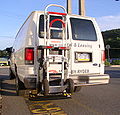2009 Ford E250 Cargo Diesel Supplement 2nd Printing - Page 5
2009 Ford E250 Cargo Manual
Page 5 highlights
Introduction Lubrication system Extended oil change intervals can negatively affect engine performance, fuel economy and engine life. Refer to the engine oil specification chart located under Engine oil specifications in the Maintenance and Specifications chapter of this supplement. On E-Series vehicles (6.0L engine), it is important to change the engine oil at the recommended service intervals because oil viscosity is important in maintaining the oil pressure required to actuate the fuel injectors. On F-Super Duty vehicles (6.4L engine), it is important to change the engine oil at the recommended service intervals to maintain oil viscosity with the addition of the diesel particulate filter (DPF). Fast start glow plug system The glow plug system consists of: • eight glow plugs • the glow plug control module (GPCM) • engine oil temperature (EOT) sensor • barometric pressure (BARO) sensor The glow plug system is electronically controlled by the PCM. The GPCM energizes the glow plugs immediately after the ignition is placed in the ON position, then determines how long the glow plugs will be on according to the EOT and BARO sensors. The required time for the glow plugs to be energized decreases as the engine oil temperature and barometric pressure increase. Engine cooling system The engine cooling system contains an engine oil cooler and an Exhaust Gas Recirculation (EGR) cooler. The oil cooler's function is to regulate engine oil temperature. The EGR cooler function is to cool exhaust gases before they are circulated back through the engine to reduce emissions. Vehicles with diesel engines typically are used to carry heavy loads and accumulate mileage rapidly. These two factors may cause the additives in the coolant to "wear out" in a shorter time. Refer to the Special Operating Conditions section for more information about coolant additives and coolant change intervals. Operating the engine with insufficient coolant and/or coolant additive can cause severe engine damage. 5 2009 Econoline (eco) Supplement, 2nd Printing USA (fus)















